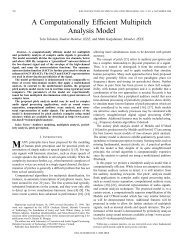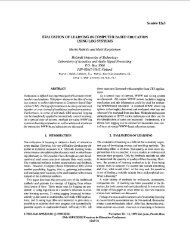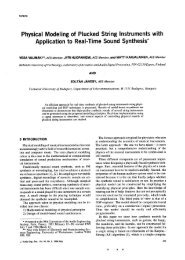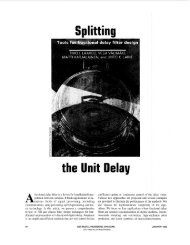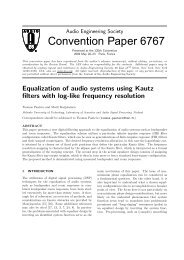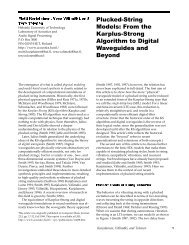On the numerical solution of the 2D wave equation
On the numerical solution of the 2D wave equation
On the numerical solution of the 2D wave equation
Create successful ePaper yourself
Turn your PDF publications into a flip-book with our unique Google optimized e-Paper software.
Proc. <strong>of</strong> <strong>the</strong> 11 th Int. Conference on Digital Audio Effects (DAFx-08), Espoo, Finland, September 1-4, 2008<br />
Stanfard Leap Frog (SLF) Rotated Leap Frog (RLF) Interpolated (INT) Implicit<br />
(n+1)<br />
(n)<br />
(l-1,m-1) (l,m-1)<br />
(l+1,m-1)<br />
(l+1,m+1 )<br />
(l+1,m)<br />
(l-1,m-1) (l,m-1) (l+1,m-1)<br />
(l+1,m)<br />
(l+1,m+1 )<br />
(l-1,m-1) (l,m-1) (l+1,m-1)<br />
(l+1,m)<br />
(l+1,m+1 )<br />
(l-1,m-1) (l,m-1) (l+1,m-1)<br />
(l+1,m)<br />
(l+1,m+1 )<br />
(n-1)<br />
Figure 1: Compact FDTD Stencils. For each type <strong>of</strong> stencil, <strong>the</strong> middle node at time (n + 1) is updated using <strong>the</strong> remaining black-coloured<br />
nodes.<br />
3. ANALYSIS OF SPECIAL CASES<br />
Table 1 lists seven special cases <strong>of</strong> compact schemes. The standard<br />
leapfrog (SLF) scheme is ma<strong>the</strong>matically equivalent to <strong>the</strong> rectilinear<br />
digital <strong>wave</strong>guide mesh [8], and has exactly <strong>the</strong> same dispersion<br />
relation as Yee's classic FDTD scheme [15, 2]. As explained<br />
in [5], <strong>the</strong> rotated leap fog (RLF) scheme can be interpreted as applying<br />
standard centered nite operators along <strong>the</strong> diagonals ra<strong>the</strong>r<br />
than <strong>the</strong> horizontal and vertical axes. <strong>On</strong>e could say that <strong>the</strong> RLF<br />
stencil is 45 o rotated in comparison to <strong>the</strong> SLF scheme; both use<br />
a “6-point stencil” in <strong>the</strong> space-time grid to update <strong>the</strong> new value<br />
at time (n + 1) (see Fig. 1). Linear combinations <strong>of</strong> <strong>the</strong> SLF and<br />
<strong>the</strong> RLF also exist, which result in a 10-point update stencil (see<br />
Fig. 1). Such schemes, for which a = 0 and 0 < b < 1 2, have<br />
been referred to as `interpolated schemes' [5]. We have listed two<br />
special cases <strong>of</strong> interpolated schemes in Table 1. As a reference to<br />
o<strong>the</strong>r studies, it is useful to point out that <strong>the</strong> interpolated scheme<br />
with b = 1 and λ = p 1<br />
6 2<br />
is nearly equivalent to <strong>the</strong> interpolated<br />
digital <strong>wave</strong>guide mesh [10], <strong>the</strong> latter having b = 0.1879.<br />
Table 1: Special cases <strong>of</strong> compact FDTD schemes.<br />
scheme a b stability bound<br />
SLF 0 0 λ ≤ p 1<br />
2<br />
RLF 0<br />
1<br />
2<br />
λ ≤ 1<br />
INT(1/4) 0<br />
1<br />
4<br />
λ ≤ 1<br />
INT(1/6) 0<br />
1<br />
6<br />
λ ≤ p 3<br />
4<br />
MFI<br />
1<br />
4 − 1<br />
2 √ 3<br />
FOA<br />
1−λ 2<br />
12<br />
1<br />
6<br />
λ ≤ 1<br />
1<br />
λ ≤ √ 3 − 1<br />
6<br />
OPT 0.0492 0.228 λ ≤ 0.77<br />
The remaining special cases in Table 1 are implicit schemes,<br />
which use a 26-point update stencil (see Fig. 1). The maximally<br />
at isotropic (MFI) scheme is <strong>the</strong> scheme for which <strong>the</strong> difference<br />
between axial and diagonal relative phase velocity is maximally<br />
at. Such a scheme is particularly useful when <strong>the</strong> aim is to apply<br />
(<strong>of</strong>f-line) pre- and post-warping techniques in order to remove as<br />
much as possible any direction-independent <strong>numerical</strong> dispersion,<br />
such as those presented in [9].<br />
The implicit scheme with a = 1−λ2 and b = 1 12 6, originally<br />
identied in [16], denes a subgroup <strong>of</strong> schemes within <strong>the</strong> familiy<br />
<strong>of</strong> Eq. (6) <strong>of</strong> fourth-order accuracy (FOA), as can be seen directly<br />
from Eq. (45).<br />
The OPT scheme is an optimisation example, that is computationally<br />
most efcient under <strong>the</strong> criterion that <strong>the</strong> relative phase<br />
velocity error should not exceed 1% within any specied bandwidth<br />
(see Sec. 3.2).<br />
3.1. Relative Phase Velocity<br />
In Fig. 2, <strong>the</strong> relative phase velocity, as calculated with (30), is<br />
plotted as a function <strong>of</strong> <strong>the</strong> <strong>wave</strong>numbers. What can be immediately<br />
observed from <strong>the</strong>se plots is how `isotropic' a particular<br />
scheme is. For example, <strong>the</strong> INT(1/6) scheme (results plotted for<br />
both λ 2 = 0.75, which is <strong>the</strong> stability bound, and λ 2 = 0.5,<br />
which coincides with <strong>the</strong> interpolated digital <strong>wave</strong>guide mesh) and<br />
<strong>the</strong> MFI scheme are far more `round' than <strong>the</strong> o<strong>the</strong>r special cases.<br />
Note that <strong>the</strong> MFI scheme is <strong>the</strong> most isotropic <strong>of</strong> <strong>the</strong> three.<br />
What is difcult - if not impossible - to determine from <strong>the</strong>se<br />
plots is <strong>the</strong> <strong>numerical</strong> dispersion at a certain frequency. In some<br />
studies [11, 17], a circle is drawn on plots <strong>of</strong> this type with <strong>the</strong> intention<br />
<strong>of</strong> indicating <strong>the</strong> “highest normalised temporal frequency”.<br />
Unfortunately this does not work, since <strong>the</strong> <strong>wave</strong>numbers (spatial<br />
frequencies) are not proportional to <strong>the</strong> temporal frequencies (this<br />
follows straight from <strong>the</strong> dispersion relation).<br />
It is however possible to convert a set <strong>of</strong> <strong>wave</strong>numbers (ˆk x, ˆk y)<br />
to frequency ω (using Eq. (29)) and angle <strong>of</strong> propagation θ. This<br />
way `polar plots' <strong>of</strong> <strong>the</strong> relative phase velocity can be generated,<br />
where <strong>the</strong> polar radius corresponds to (normalised) frequency and<br />
<strong>the</strong> polar angle indicates <strong>the</strong> direction (see Fig. 3). Now we may<br />
draw circles on <strong>the</strong> plot in order to indicate particular frequencies.<br />
These plots also immediately reveal <strong>the</strong> cut-<strong>of</strong>f frequency<br />
for any direction (beyond which <strong>wave</strong>s in <strong>the</strong> discrete system are<br />
evanescent and dispersion is <strong>of</strong> highly reduced relevance). As can<br />
be seen, only <strong>the</strong> INT(1/4) scheme lls <strong>the</strong> complete bandwidth<br />
up to Nyquist for all directions, while <strong>the</strong> SLF, <strong>the</strong> RLF, and <strong>the</strong><br />
INT(1/6) with λ 2 = 0.5 have <strong>the</strong> most `severe' cut-<strong>of</strong>f frequencies<br />
İt can also be observed from Fig. 3 that <strong>the</strong> FOA and <strong>the</strong> OPT<br />
scheme have <strong>the</strong> largest bandwidth in which <strong>the</strong> <strong>numerical</strong> dispersion<br />
remains relatively small. Amongst <strong>the</strong> explicit schemes, <strong>the</strong><br />
INT(1/6) (with λ 2 = 0.75) and <strong>the</strong> INT(1/4) scheme perform relatively<br />
well in that regard.<br />
A general observation that can be made is that <strong>the</strong> highest <strong>numerical</strong><br />
dispersion consistently occurs in ei<strong>the</strong>r <strong>the</strong> axial or <strong>the</strong> diagonal<br />
direction. Hence perhaps <strong>the</strong> most useful and informative<br />
is to plot <strong>the</strong> relative phase velocity only for <strong>the</strong>se directions, as<br />
depicted in Fig. 4. This allows better to observe <strong>the</strong> exact value <strong>of</strong><br />
DAFX-4






